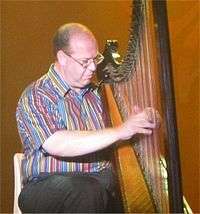Robin Huw Bowen

Robin Huw Bowen is a player of the Welsh Triple Harp, known in Welsh as Telyn Deires (English: Three-row Harp),[1] and is recognised internationally as the leading exponent of the instrument. He was awarded the Glyndŵr Award in 2000.
Born into the Welsh community in Liverpool, England into a family originally from Anglesey, Robin learned to play the simple Celtic Harp while at school, inspired by the Breton harper, Alan Stivell. In 1979 he received a degree in Welsh Language and Literature from the University of Wales, Aberystwyth.
He was first exposed to the more complicated Welsh Triple Harp by two members of the Welsh traditional music group Ar Log, brothers Dafydd and Gwyndaf Roberts. They had learned to play the instrument from Nansi Richards, one of the last truly traditional Welsh folk harpists from the previous generation, and the very last to still play the Welsh Triple harp in the correct traditional manner.
Although he regularly performs as a soloist, Robin joined the Welsh traditional group Mabsant in 1986 and later joined Cusan Tân. Since 1998 he has been a member of the Welsh 'super-group' Crasdant. In 2004 he and four other Triple Harpists formed Rhes Ganol, the very first Welsh Triple Harp 'Choir' to exist since that of Llanover Court during its heyday at the beginning of the twentieth century.
Robin Huw Bowen worked for many years at the National Library of Wales in Aberystwyth. While there he discovered several old collections of Welsh tunes and arrangements for harp, some of which have since been published either by the Library or by his own music publishing company, Gwasg Teires. His research has also drawn on living sources, in particular the harpist Eldra Jarman (great granddaughter of John Roberts ('Telynor Cymru') the last exponent of the true Welsh Gypsy harping tradition.
Albums
- Trwy'r Weiar - Through the Wire (1987) with Mabsant
- Telyn Berseiniol Fy Ngwlad - Sweet Harp of My Land (1991)
- Cusan Tân - Kiss of Fire (1992) with Cusan Tân
- Hela'r Draenog - Hunting the Hedgehog (1994)
- Cerddoriaeth Telyn Cymru - Harp Music Of Wales (1995)
- Esgair - The Ridge (1996) with Cusan Tân
- Hen Aelwyd - Old Hearth (1999)
- Crasdant (1999) with Crasdant
- Nos Sadwrn Bach - Not Yet Saturday (2001) with Crasdant
- Yn y Gwaed - In the Blood (2004) with Rhes Ganol https://www.discogs.com/Rhes-Ganol-Yn-Y-Gwaed/release/1865198
- Dwndwr - The Great Noise (2005) with Crasdant
- Y Ffordd i Aberystwyth - The Road to Aberystwyth (2007)
- Harp Music of Wales - Cerddoriaeth Telyn Cymru (2011)
- Iaith Enaid (2015)
References
- ↑ Harris, Craig. "Robin Huw Bowen". Allmusic. Retrieved 29 August 2011.